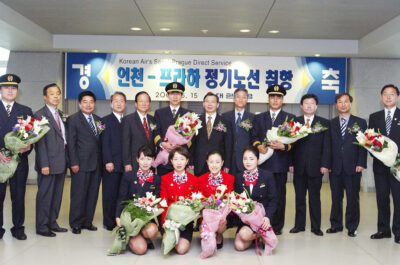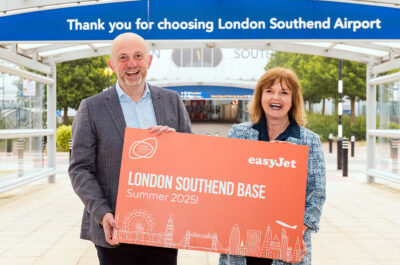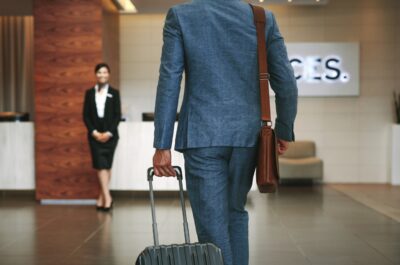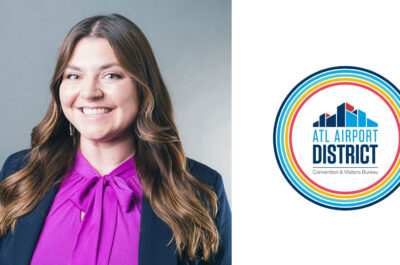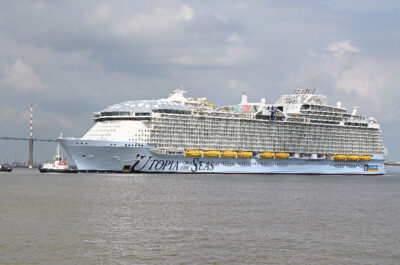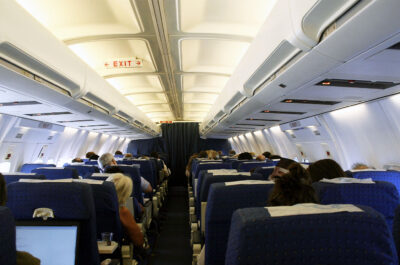…
 As one of Europe’s leading providers of ancillary revenue services (read: new income and profit streams) for low‐cost, regional and small airlines, we wanted to share with you a summary of trends that have impacted our industry, and that will affect the way we do business in 2008. From the growing number of carbon offset initiatives, to self‐service kiosks and charging stations, to the unbundling of services that consumers have traditionally paid for, the coming year holds many new opportunities for our industry to engage with today’s rapidly changing and demanding traveler, while adding value and visibility to our brands. Importantly, these new trends indicate a shift in business models which we must embrace, in order to stay on top of our game. But while the abundance of new trends ‐ like the pervasive greening of businesses ‐ provide enormous comfort to consumers and are a contributor in the purchase‐decision process, we must not lose sight of our business goals. To expand market‐share, provide excellent service and/or value to customers, and produce profits. So with that said, following is an overview of our top ten travel trends for 2008;
As one of Europe’s leading providers of ancillary revenue services (read: new income and profit streams) for low‐cost, regional and small airlines, we wanted to share with you a summary of trends that have impacted our industry, and that will affect the way we do business in 2008. From the growing number of carbon offset initiatives, to self‐service kiosks and charging stations, to the unbundling of services that consumers have traditionally paid for, the coming year holds many new opportunities for our industry to engage with today’s rapidly changing and demanding traveler, while adding value and visibility to our brands. Importantly, these new trends indicate a shift in business models which we must embrace, in order to stay on top of our game. But while the abundance of new trends ‐ like the pervasive greening of businesses ‐ provide enormous comfort to consumers and are a contributor in the purchase‐decision process, we must not lose sight of our business goals. To expand market‐share, provide excellent service and/or value to customers, and produce profits. So with that said, following is an overview of our top ten travel trends for 2008;
1) Green Initiatives ‐ Carbon offsets
All signs point to a continuance of the eco‐friendly phenomenon in the new year. The Bali conference on the future of the Kyoto protocol, Al Gore’s Nobel Peace Prize for climate change awareness, a Democratic‐focused US presidential election cycle, and oil prices closing in on $100 a barrel have all served to keep environmental conservationism at the forefront of travelers’ consciousness’ as 2007 ends and will continue well into 2008. Carbon offset programs have enjoyed limited success, but are poised to really take off in the current environment. According to “A Consumer’s Guide to Retail Carbon Offset Providers”, prepared by Trexler Climate and Energy Services for the Clean Air‐Cool Planet group, 2000 miles of air travel generates one full ton of the greenhouse gas CO2, the mitigation of which environmentally‐minded consumers would certainly be willing to pay for. The purchase of such offsets, along with well‐positioned announcements about a company’s environmental policies, can be integrated into a booking platform, like Atlas‐Blue.com’s carbon offset program which launches on Jan 1, 2008.
2) Ancillary Services
The development of ancillary revenue streams has become increasingly important for airlines struggling to compete in a business environment facing very real price constraints and escalating variable costs (i.e., fuel). Low, or zero overhead service offerings like trip insurance, simultaneous hotel booking and rental car options are already mainstays on airline booking engines; look for additional services and products to appear alongside them. As one of the travel industry’s leaders in ancillary revenue creation, we are facilitating the growth of these “extras” such as one‐day airport lounge upgrades, priority luggage handling, online/onboard gaming and entertainment. This is just a small offering of what’s to come.
3) Airport Lounges and Entertainment
As more fliers take to the skies, the amount of time they spend in airports is increasing. Still‐tight security and governmental agency recommendations have increased this time by requiring fliers to be in the airport earlier. While average delay times have remained in the 15‐45 minute range, the longest delays are getting longer, according to flightstats.com, with average times of nearly an hour. With a very captive audience seeking diversion during thee expanding wait times, airport lounges (especially to those without loyalty programs that offer access) and on‐ground entertainment are potentially lucrative opportunities.
4) Strong Euro= European vacationers
Of the many macroeconomic factors that will affect global travel in 2008, the projected rise of the Euro compared to the US dollar will perhaps be the most significant in the short term. The dollar is now at a 26 year low against the British Pound and at an all time low against the Euro ($1.43 to €1, at the time of this writing). We can expect many more Europeans to seek discount vacations in the US, taking advantage of the favorable exchange rate, and increasing transatlantic travel as a result. Furthermore, as corroborated by the New York Times on Dec. 11, the traveling demographic will be bargain‐seeking, web‐savvy, and used to the sort of low‐cost carriers that are so popular on the Continent, effectively depressing the price of a pond crossing. In this circumstance, group purchasing and other means of keeping costs in check will become an imperative.
5) American Recession
The flip side to the Euro boom is the deflated dollar, which at the end of 2007 is coinciding with the beginnings of a US recession. The typical US traveler has consistently sought the lowest possible price for an airline ticket anyway, and an economic downturn will only serve to intensify this trend. With less travelers seeking ever‐lower fares, the unbundling of services, ancillary revenue creation, and cost conservation will become more important to US carriers. European carriers can expect fewer American fliers.
6) The use of regional jets
In the US, this corresponds slightly with the impending recession, as carriers will seek to maximize load factors through the use of smaller aircraft. Regional planes, used primarily to connect outlying airports with major hubs, are increasingly used for hub‐to‐hub travel when the flights are relatively short (MIA to NYC, for instance). This allows airlines to offer more flights throughout the day, a major consumer priority, but also allows them to ensure that the flights will be booked solid, as opposed to a larger jet that might fly only partially full. The average jetliner has 137 seats‐ while 23 seats fewer on average than 5 years ago, that number of seats is still harder to fill than the 35‐70 seats of a regional jet. As such, the use of regional jets has increased 200% in the same time span. This trend can go either way, as evidenced by Southwest’s marketing campaign advertising a ‘full sized plane each flight’, but is likely to continue through 2008.
7) RFID tags on luggage
Radio Frequency Identification Tags are used by many other industries for inventory control, delivery tracking and loss prevention. 2008 may be the year they become widespread in the airline business. RFID could be offered as an ancillary service (on the Airsavings booking platform, for example), as a system‐wide customer service initiative, as a security measure, or as part of a customer loyalty program. Following a year where more luggage was lost than in any previous year, allowing passengers to be able to track their own bags might be a significant way to stem negative publicity for the industry as a whole. Airlines that have instituted a pilot RFID program for internal use include Delta, British Airways and Japan Air.
8) Charging stations for laptops, cell phones, ipods, etc.
The frequent traveler in 2008 carries more computing power on their person than the first commercial airplanes had in their cockpits. Every gadget needs to be recharged‐ this major convenience can be offered at a small fee. Charging stations have emerged in airport lounges and malls on a small scale in 2007; Samsung, an early adopter, has sponsored charging stations in Dallas‐Ft Worth, LAX, and New York’s JFK airports, according to a New York Times article, and is reaping rewards in terms of brand awareness and exposure. 2008 should see a significant increase in such services.
9) More self‐service kiosks
Today’s traveler is far more self‐reliant and more familiar with airport procedures than ever before. Many airlines (Lufthansa, AirCanada, BA, Delta) have already capitalized on this by offering self‐check‐in, enabling significant labor savings (and therefore cost savings) at the ticket counter. Look for this trend to continue in 2008 as kiosk and interface technology advance and hourly personnel become more expensive.
10) Frequent flyer/loyalty programs
In the age of lowest‐price‐guarantees and choose‐your –fare booking, natural loyalty is at an all‐time low. Look for carriers to step up their push for repeat customers through expansion of their frequent flier and loyalty programs. Expansion may take the form of incentives, as through the granting of extra privileges demonstrated by Airsavings’ programs, or with a marketing push.
Raphael Bejar is CEO and founder of Airsavings, based in France with offices in Singapore. Bejar has more than 15 years airline industry experience and founded Airsavings in 2001 to meet the unique and growing needs of low cost and mid sized airlines. His company combines innovative group buying techniques with web services technology to provide ancillary revenue solutions to those airlines. Bejar is a frequent speaker and contributor at industry conferences and events, on the topics of ancillary revenues and cost‐reduction strategies for airlines.





















